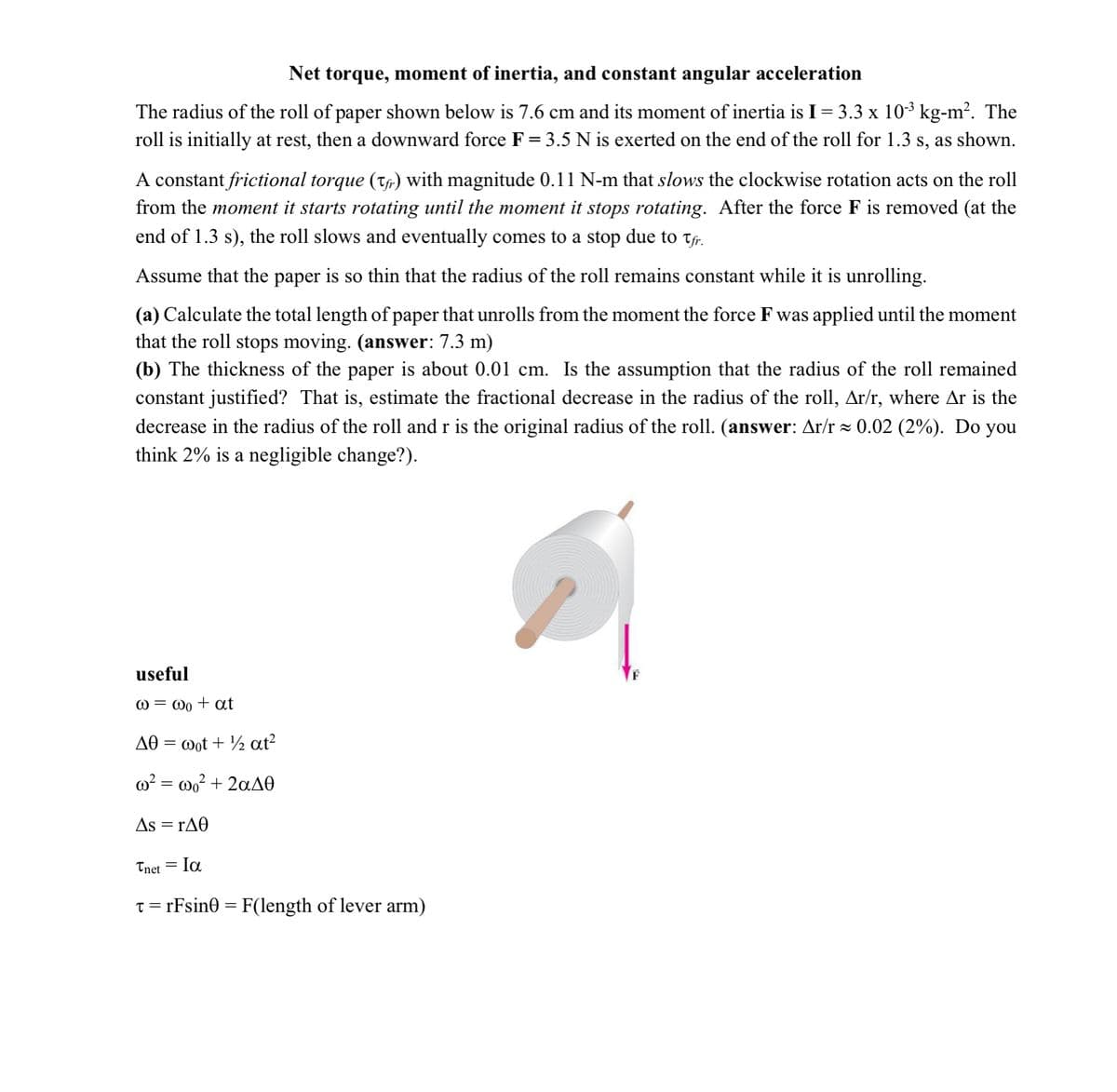The radius of the roll of paper shown below is 7.6 cm and its moment of inertia is I= 3.3 x 10³ kg-m². The roll is initially at rest, then a downward force F = 3.5 N is exerted on the end of the roll for 1.3 s, as shown. A constant frictional torque (t,) with magnitude 0.11 N-m that slows the clockwise rotation acts on the roll from the moment it starts rotating until the moment it stops rotating. After the force F is removed (at the end of 1.3 s), the roll slows and eventually comes to a stop due to t. Assume that the paper is so thin that the radius of the roll remains constant while it is unrolling. (a) Calculate the total length of paper that unrolls from the moment the force F was applied until the moment that the roll stops moving. (answer: 7.3 m) (b) The thickness of the paper is about 0.01 cm. Is the assumption that the radius of the roll remained constant justified? That is, estimate the fractional decrease in the radius of the roll, Ar/r, where Ar is the decrease in the radius of the roll and r is the original radius of the roll. (answer: Ar/r 0.02 (2%). Do you think 2% is a negligible change?).
The radius of the roll of paper shown below is 7.6 cm and its moment of inertia is I= 3.3 x 10³ kg-m². The roll is initially at rest, then a downward force F = 3.5 N is exerted on the end of the roll for 1.3 s, as shown. A constant frictional torque (t,) with magnitude 0.11 N-m that slows the clockwise rotation acts on the roll from the moment it starts rotating until the moment it stops rotating. After the force F is removed (at the end of 1.3 s), the roll slows and eventually comes to a stop due to t. Assume that the paper is so thin that the radius of the roll remains constant while it is unrolling. (a) Calculate the total length of paper that unrolls from the moment the force F was applied until the moment that the roll stops moving. (answer: 7.3 m) (b) The thickness of the paper is about 0.01 cm. Is the assumption that the radius of the roll remained constant justified? That is, estimate the fractional decrease in the radius of the roll, Ar/r, where Ar is the decrease in the radius of the roll and r is the original radius of the roll. (answer: Ar/r 0.02 (2%). Do you think 2% is a negligible change?).
Elements Of Electromagnetics
7th Edition
ISBN:9780190698614
Author:Sadiku, Matthew N. O.
Publisher:Sadiku, Matthew N. O.
ChapterMA: Math Assessment
Section: Chapter Questions
Problem 1.1MA
Related questions
Question

Transcribed Image Text:Net torque, moment of inertia, and constant angular acceleration
The radius of the roll of paper shown below is 7.6 cm and its moment of inertia is I= 3.3 x 10-3 kg-m². The
roll is initially at rest, then a downward force F = 3.5 N is exerted on the end of the roll for 1.3 s, as shown.
A constant frictional torque (Tf.) with magnitude 0.11 N-m that slows the clockwise rotation acts on the roll
from the moment it starts rotating until the moment it stops rotating. After the force F is removed (at the
end of 1.3 s), the roll slows and eventually comes to a stop due to tr.
Assume that the paper is so thin that the radius of the roll remains constant while it is unrolling.
(a) Calculate the total length of paper that unrolls from the moment the force F was applied until the moment
that the roll stops moving. (answer: 7.3 m)
(b) The thickness of the paper is about 0.01 cm. Is the assumption that the radius of the roll remained
constant justified? That is, estimate the fractional decrease in the radius of the roll, Ar/r, where Ar is the
decrease in the radius of the roll and r is the original radius of the roll. (answer: Ar/r = 0.02 (2%). Do you
think 2% is a negligible change?).
useful
@ = @o + at
Δθ ω0t + αt
o? = wo? + 2aAO
As = rA0
Tnet
= la
T = rFsin0 = F(length of lever arm)
Expert Solution
Step 1
Solution:
Given Data:
F = 3.5 N
r = 7.6 cm
I = 3.3 X 10-3 kg-m2
t = 1.3 s
Tf = 0.11 N-m
Trending now
This is a popular solution!
Step by step
Solved in 4 steps

Knowledge Booster
Learn more about
Need a deep-dive on the concept behind this application? Look no further. Learn more about this topic, mechanical-engineering and related others by exploring similar questions and additional content below.Recommended textbooks for you

Elements Of Electromagnetics
Mechanical Engineering
ISBN:
9780190698614
Author:
Sadiku, Matthew N. O.
Publisher:
Oxford University Press

Mechanics of Materials (10th Edition)
Mechanical Engineering
ISBN:
9780134319650
Author:
Russell C. Hibbeler
Publisher:
PEARSON

Thermodynamics: An Engineering Approach
Mechanical Engineering
ISBN:
9781259822674
Author:
Yunus A. Cengel Dr., Michael A. Boles
Publisher:
McGraw-Hill Education

Elements Of Electromagnetics
Mechanical Engineering
ISBN:
9780190698614
Author:
Sadiku, Matthew N. O.
Publisher:
Oxford University Press

Mechanics of Materials (10th Edition)
Mechanical Engineering
ISBN:
9780134319650
Author:
Russell C. Hibbeler
Publisher:
PEARSON

Thermodynamics: An Engineering Approach
Mechanical Engineering
ISBN:
9781259822674
Author:
Yunus A. Cengel Dr., Michael A. Boles
Publisher:
McGraw-Hill Education

Control Systems Engineering
Mechanical Engineering
ISBN:
9781118170519
Author:
Norman S. Nise
Publisher:
WILEY

Mechanics of Materials (MindTap Course List)
Mechanical Engineering
ISBN:
9781337093347
Author:
Barry J. Goodno, James M. Gere
Publisher:
Cengage Learning

Engineering Mechanics: Statics
Mechanical Engineering
ISBN:
9781118807330
Author:
James L. Meriam, L. G. Kraige, J. N. Bolton
Publisher:
WILEY